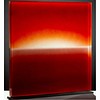Norman Rockwell (1894-1978) New York / Massachusetts, Duotone Print. Titled ‘No Swimming’ 1972. Hand-signed by Norman Rockwell duotone print. The offset print is of the image of the June 4, 1921, Saturday Evening Post magazine cover. The Norma Rockwell magazine covers were printed in duotone until 1926. Printed by Harry Abrams Publishers, 1972. The wording on the bottom of the print includes the following: Norman Rockwell No Swimming, Painted for cover of ’The Saturday Evening Post’ of June 4, 1921 Printed in Japan 1921 The Curtis Publishing Company.
Overall Size: 27 x 22 5/8 in.
Sight Size: 21 1/8 x 17 3/8 in.
Frame Thickness: 1 in.
Book Size: 9 1/8 x 12 1/8 x 1 in.
#1347 .
Mr. Rockwell began his illustrious career with immediate success when he painted Christmas cards, for his first commission, at age sixteen, and illustrated his first book one year later. Aglow with success, the determined young man signed his name in blood, swearing never to do advertising jobs. He kept that promise until his first known advertisement for H. J. Heinz Company, Pork'n Beans, appeared in the 1914 edition of the Boy Scout Handbook.The first advertisement by Norman Rockwell to appear in The Saturday Evening Post was January 13, 1917. His first Post cover was published on May 20, 1916. Much of Rockwell's prodigious output was painted for magazine reproduction and never intended to provide enduring examples of his work. Due to his own technique of using a special compound between layers of paint, some of his originals have yellowed with age, but the aging hasn't diminished his popularity nor the demand for "anything Rockwell." After many years of being scorned as an unworthy imitator, Norman Rockwell's human interpretation of the American scene survived the criticism of art connoisseurs. His work was revered, year after year on magazine covers by two generations of Rockwell watchers: Those who recalled and those too young to remember. Although Norman Rockwell, himself, eventually became as recognizable as one of his illustrations, such recognition was too little and very late. His first photograph accompanied illustrations in a 1914 Boys' Life magazine, but few biographical sketches appeared prior to 1945. The Saturday Evening Post first printed information about Rockwell in 1926, ten years and 82 covers after their association began. Rockwell made no secret of his lifetime preference for countrified realism-- "Things happen in the country, but you don't see them. In the city you are constantly confronted by unpleasantness. I find it sordid and unsettling." He believed the time he spent in the countryside was a great influence on his idyllic approach to storytelling on canvas. Though Rockwell was unrepentant about his rural preference, he was surprisingly charitable toward contemporaries who shunned his technique in favor of modern art. Perhaps the most provocative opinion on Rockwell's work was expressed in a November 13,1970 issue of Life magazine. When the editors brought the dilemma of Rockwell's art popularity and lack of recognition, to their reading public in a one page article, posing the question: "If We All Like It Is It Art?" Their readers promptly responded. The resulting action from ordinary people around the world created the first -man art revolution in America, far surpassing Currier and Ives. A few months later, the first Norman Rockwell plate, The Family Tree, was fired; the Rockwell Revolution had started, and the first of millions of collectibles were offered to Rockwell loving minions. It was then that author, Thomas Buechner and publisher, Harry Abrams moved Rockwell out of the closet, and onto the world's coffee tables. The rest is art history. By 1978, at the height of his popularity, and the year of his death, forty books and 140 articles chronicling Rockwell's accomplishments had appeared in over 56 publications. Location Book- U Rack, Piece on P
Available payment options
We accept all major credit cards, wire transfers, money orders, checks and PayPal. Please give us a call at (941) 359-8700 or email us at SarasotaEstateAuction@gmail.com should you have any questions about payment.





















